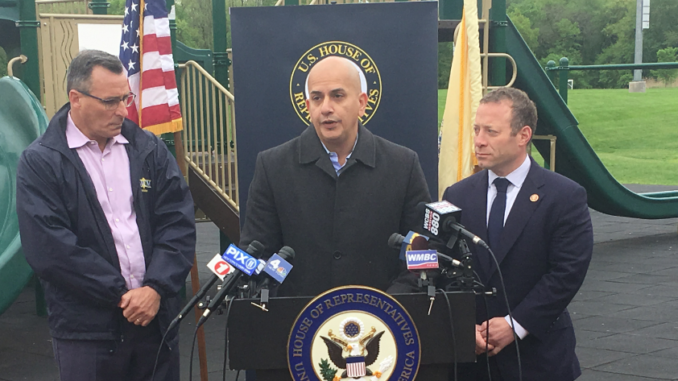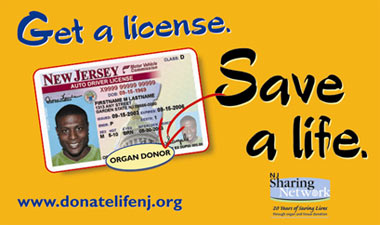
WESTWOOD, N.J.—It’s been a year since Miranda Faith Vargas, 10, lost her life in a tragic and criminal school bus wreck. Her father, Joevanny Vargas, says the word anniversary is the wrong word for the occasion.
An anniversary, he said in Westwood on May 15, is for a happy occasion such as a sweet sixteen, graduation, or a wedding—none of which his little girl will ever get to have.
But she lives on in the family’s heart, and her memory and name are fueling a fight Vargas intends to win: he’s campaigning for bipartisan federal bus safety legislation requiring lap-and-shoulder seat belts on all school buses and real-time background checks for all bus drivers.
He’s going to Capitol Hill to make sure it passes.
Backed by a solemn Rep. Josh Gottheimer (D-5) and Westwood Mayor John Birkner Jr. at the playground of Westvale Park last Wednesday, Vargas told gathered network television cameras and reporters that he’s fighting for the measures.
The Secure Every Child Under the Right Equipment Standards (SECURES) Act requires seat belts on all school buses, makes three-point lap-and-shoulder seat belts the national standard, and encourages innovative measures to ensure students actually wear their seat belts while on school buses.
The bipartisan Miranda Vargas School Bus Driver Red Flag Act—Miranda’s Law—ensures real-time background checks so that when a school bus driver has any driving infraction beyond a parking ticket, the school or school bus company will receive an alert about that infraction from the Department of Transportation within 24 hours.
In December 2018, Gov. Phil Murphy signed a package of school bus safety bills into law raising safety standards for school buses and their operators in New Jersey.
‘This is a national problem…’
“This is not a New Jersey problem. This is a national problem that needs to be addressed before we’re confronted with another tragedy,” Vargas said, reading, sometimes, haltingly, from prepared remarks.
Vargas said his family—he, his wife Lorena, and Miranda’s twin sister Madison—was “destroyed” after Miranda and East Brook Middle School (Paramus) fifth-grade teacher Jennifer Williamson, 51, were killed on a class trip May 17, 2018 to a historic park when their bus and a dump truck collided on Route 80 in western Morris County.
Forty-three other children in the bus were injured, some critically.
The bus driver, a 77-year-old who’d had his driver’s license revoked 14 times before the wreck, allegedly cut across three lanes of traffic in an illegal U-turn on the highway and was T-boned.
He was charged on two counts of reckless vehicular homicide and 41 counts of assault by auto. He faces trial this year.
“This is commonsense legislation. It’s not about Republicans or Democrats. It’s about moms and dads,” Vargas said.
He said he is eager to join Gottheimer in Washington, D.C., this spring to tell his story on Capitol Hill.
Gottheimer said he was reintroducing the measures and had support from co-sponsors and others to give it a fighting chance.
“Like everyone here, I remember that May day like it was yesterday. Only hours after the tragedy, one parent called me and asked if the bus had seat belts and if the children were wearing them,” he said.
He continued, “I immediately checked with the school and I was told that indeed the children were buckled up, with lap belts, as required by New Jersey law. In fact, at the time, New Jersey was only one of eight states in the country where large school buses must have lap belts, not three point, lap-and-shoulder seat belts like every car and truck is required by law—and for good reason.”
Gottheimer said, “It was shocking to me that only eight states require any type of seat belts, put aside the kind of seat belt. Every day, nearly 600,000 school buses carry more than 25 million students to and from school, activities, and class trips.”
He said, “We don’t allow our children to ride without their seat belts when they’re in our cars. Yet, in buses they could?”
Gottheimer said that although it still pains Paramus “and so many of us, we are here to help turn tragedy into hope for other children and families—hope that no one will have to live through what the Vargas and Williamson families have had to live through this past year.”
He said he is grateful that Vargas is joining him in Washington so that he can tell his story to members of Congress “on why our communities so desperately need this bipartisan legislation.”
When a reporter asked why the measures were not approved after they were read in 2018, Gottheimer agreed that passing the reforms is a priority.
Gottheimer recalled Williamson as a wonderful caring teacher “who was also tragically taken from this community and from her family. I was so glad to see that a beautiful memorial was recently dedicated to Jennifer and Miranda in Besen Park in Paramus.”
Both Gottheimer and Birkner lent Vargas physical and emotional support as he spoke, at least twice putting a hand on his back as he described his family’s loss and determination.
According to Gottheimer:
- From 2000 to 2014, the General Accounting Office found there were an average of 115 fatal crashes involving school buses each year.
- A National Transportation Safety Board report on a fatal 2016 rollover bus crash in Chattanooga, Tennessee that killed six young children found that the lack of three-point belts contributed to the severity of the crash.
- In a 2014 bus crash in Anaheim, California, nine students and the driver were injured. This was the first crash in the nation involving a school bus that was equipped with three-point belts in all seating positions, as required by California law.
- The NTSB looked at what might have happened if the two most seriously injured students were wearing only lap belts and found that the outcome would have been much worse.
- Research has shown that only 50 to 80 percent of commercial drivers, including school bus drivers, actually self-report violations.
“That’s an unacceptable safety risk, because suspended drivers have a crash rate 14 times higher than other drivers,” Gottheimer said.
He added he’s also signed onto the Stop for School Bus Act, which will help prevent illegal passing of school buses.



